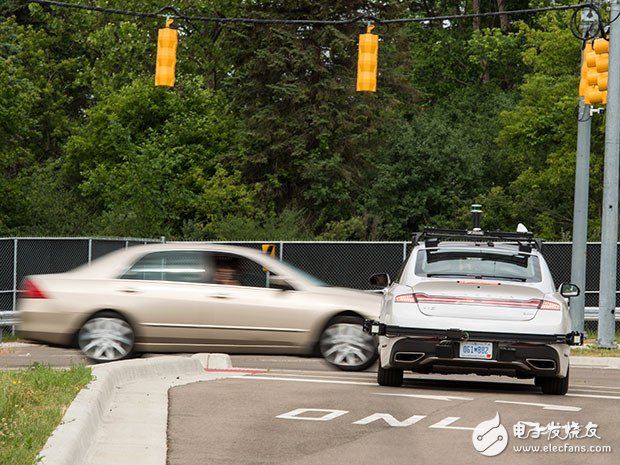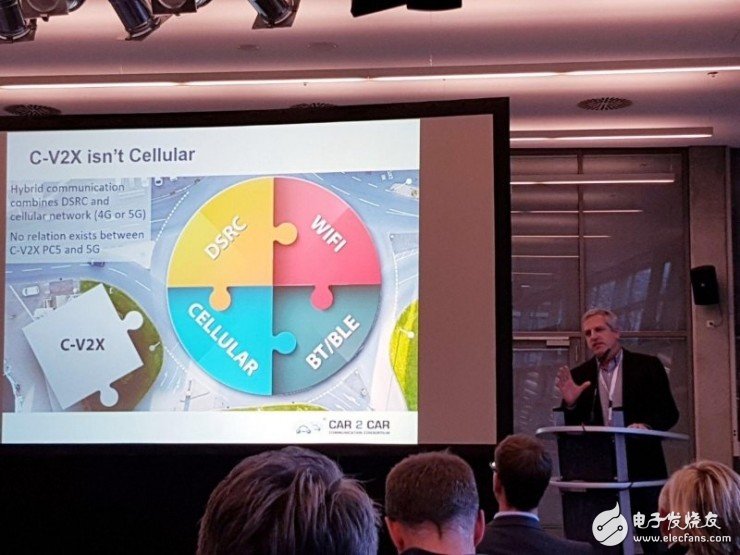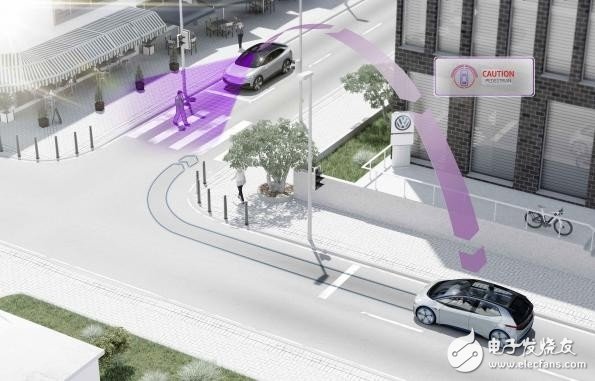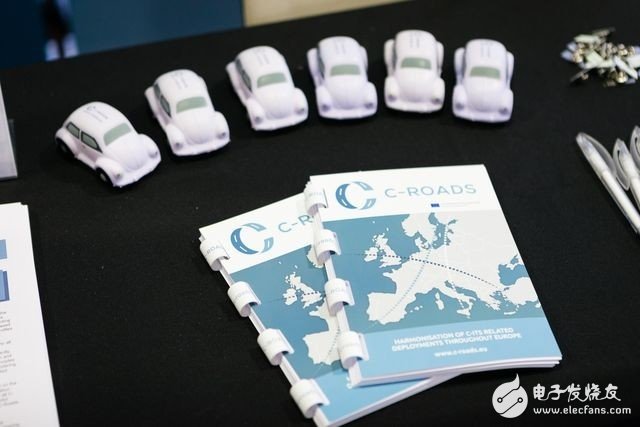If the goal of driving autonomous vehicles is to make traffic safer, highly automated car developers should begin to address the “communication failure†between people and machines.
If you think that autopilot and car communication (V2V) are two different issues, then you have to rethink.
Proponents of autonomous driving often take advantage of the utopian future of a completely accident-free road, but rarely mention the long, gradual transition period that must pass before. During this transition period, autonomous vehicles and "historical" vehicles that retain the driver also need to travel on the same road, facing the same danger.
If the goal of driving autonomous vehicles is to make traffic safer, then it is time for people developing highly automated vehicles to address the "communication failure" between people and machines.

Humans are even more dangerous when driving. In the picture, a car driven by a person flashes a red light when the autopilot test car passes through the intersection.
How to make autopilot vehicles look more?Automated vehicles are often unable to speculate on human intentions. They don't do well in predicting the sudden driving behavior of other drivers, which means they can't do anything about defensive driving. At the same time, humans are much more rude on the road than we think.
So what should I do? Only auto-driving vehicles are allowed to drive on the road? This solution is too "Utopia". And the reality is that human-powered vehicles will continue to shuttle freely on the road, keep up with the front car and suddenly change lanes indefinitely.
Alternatively, we can install more sensor technology on self-driving vehicles, giving them a “see-through†function. Unfortunately, in the real world, even X-rays cannot read the thinking of human drivers.

Autotalks CEO Hagai Zyss
Hagai Zyss, CEO of the Israeli company Autotalks, has his own set of opinions in the face of these problems.
At the Detroit North American International Auto Show in early January, he explained to the audience that "the lack of coordination between autonomous vehicles and human-powered vehicles is the result of autonomous vehicles not getting more effective information."
He said, "The car manufacturers present are aware of the need to establish a dedicated car-to-vehicle communication mechanism. This is another layer of security that we can start to save lives today."
But unfortunately, the discussion about vehicle communication was eventually "hijacked" by mobile communication advocates such as Qualcomm. The problem of V2X has become a problem of choosing DSRC (dedicated short-range communication) or 5G technology.
Of course, this is also the history of V2X. For the first time, more people are talking about 5G instead of DSRC.
Some people think that 5G will completely replace the DSRC requirements, while others believe that DSRC can not be replaced because it can meet the strict delay requirements of these applications. But one of the biggest questions is, can 5G navigation meet the delay requirements of V2V to avoid collisions?
It is understood that so far, no 5G navigation technology has been tested.
There are too many voices in the market to confuse the audio and video, which seems to form a technical competition between DSRC and 5G, but let people gradually forget that the real goal of V2V is to be safe. In the past seven to ten years, the DSRC has undergone rigorous testing and trials.
Zyss said: "(Original) From today, we can save lives, but we are watching 5G, a technology that has not really come out yet."
It is worth noting that Autotalks believes that hybrid mode is feasible, that is, cellular technology and DSRC coexist. Automakers are already using cellular technology like LTE to connect vehicles to the cloud to transfer content, download applications and update them. However, Zyss believes that cellular V2X (C-V2X) does not replace DSRC.
Not to mention that the 5G network has not yet appeared, the cellular network itself needs to solve the problem that the interconnected devices are synchronized with the base station. Zyss says that this synchronization model is very different from what V2V communication requires, and it must be done instantaneously between objects moving at high speed.
Some insiders also said that supporters who support the application of 5G to C-V2X are taking the old path of DSRC developers, trying to reproduce what DSRC supporters have designed, built and tested. In addition, cellular supporters must overcome the limitations of cellular networks in terms of efficiency and clock source when using technology for V2V applications.
Zyss believes that if autopilot taxis are really going to be available in 2019 or 2020, the industry's "safe and dedicated communication layer" installed on autonomous vehicles and human-powered vehicles may not be cautious.
How to coordinate autonomous vehicles and human-driven vehicles?Coordination between self-driving vehicles and human-driven vehicles is essential. According to Zyss, there has been an accident between autonomously driven vehicles and human-driven vehicles.
As an example, last month, a Tesla crashed into a fire truck parked on the highway. The driver said the car was in Autopilot mode, but it was not confirmed by Tesla or the official. Regardless of whether Tesla is in Autopilot mode, if the fire truck stopped in the accident can alert other vehicles a mile away, the accident could have been avoided.

Tesla crashed into a stopped fire truck
Sensors such as cameras, radars, and lidars work properly, but vehicles can still misjudge signals from these sensors.
If the vehicle can alert directly to other vehicles, this short, clear message is more likely to be conveyed loudly and clearly, Zyss explained.
According to Zyss, after the emergence of autonomous vehicles, many technology companies have chosen "independent" technology solutions. Instead of relying on “social protocols†between vehicles and infrastructure to receive dangerous alerts, they like to accomplish these tasks on their own (discovering obstacles, understanding the severity of the danger, and taking independent action).
But why are these companies not choosing to have a car directly tell other cars that are approaching?
Zyss believes that if security issues need to be addressed through redundancy, adding another communication method to the vehicle is much more practical than stacking the sensor.
Policy and field
Zyss is very good. However, the DSRC is still not close to the market penetration it needs. Currently, there is no policy to provide the necessary support for DSRC.
The auto market leaders in Japan, Europe and the United States, namely Toyota, Volkswagen and General Motors, are not already deploying DSRCs or declaring DSRC's specific deployment plans. Especially Volkswagen, which means that DSRC will not only be used in luxury cars, but will be popularized on entry-level models such as Golf.
It is understood that last year Volkswagen announced that it will deploy DSRC: "When the product is launched in 2019, the system will be based on warnings and information about local traffic risks that occur within a short period of time (to make decisions)."

In addition, Volkswagen added: "In the scope of the system, new technologies can identify potential traffic hazards. For example, vehicles that encounter emergency stops or on-board sensors detect road freezing. Within a few milliseconds, this information can be The surrounding equipment is shared so that other vehicles on the road can properly respond to this dangerous situation."
If you want to reach the standards that the public says, what technologies can do all of this work besides DSRC? But there is still a question, who is going to make it? Who should ask car manufacturers to install DSRC on their cars today?
Walking in front of Europe
The DSRC is currently being promoted in Europe, but in the name of “ITS-G5â€. According to Europe, Intelligent Transportation Systems (ITS) include telematics and various types of in-vehicle communications, between vehicles (such as cars to cars), and between vehicles and fixed locations (such as vehicles to infrastructure). .
Zyss explained that in order to help launch the driverless car, the European transportation chief Violeta Bulc has adopted a policy to start the corporate cooperation intelligent transportation system (C-ITS) in 2019. C-ITS, and its derived fully autonomous driving technologies include wireless short-range communications (ITS-G5) dedicated to automotive intelligent transportation systems, road transport, and traffic information communications.
For Europe, the more important issue is interoperability. With the advancement of C-ITS standardization initiatives, stakeholders are required to respect the interoperability of European social intelligent transportation cooperation systems.
Europe has launched a project called "C-Roads". This is a joint initiative of EU member states and road operators to test and implement C-ITS services for cross-border coordination and interoperability. Zyss pointed out that the C-Roads project will invest 350 million euros in C-ITS in 16 countries.

Under the influence of the C-Roads project, in 2017, countries are already deploying road infrastructure for ITS-G5 technology. In general, the DSRC has been deployed, and so far, only the DSRC is allowed by the EU regulations.
Some of us may consider DSRC as a DOA. But never underestimate the possibility of testing the true V2V communication technology used in other parts of the world.
Highly automated car supporters should never lose sight of the value that V2V can bring to autonomous driving. Communication technology significantly enhances security, not only for autonomous vehicles, but also for human-driven vehicles that are driving on the same road.
Engine Parts Belt,Water Pump Belt,fan belt,dynamo belt
Chongqing LDJM Engine Parts Center , https://www.ckcummins.com